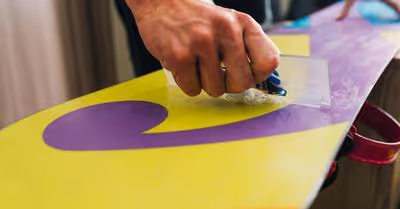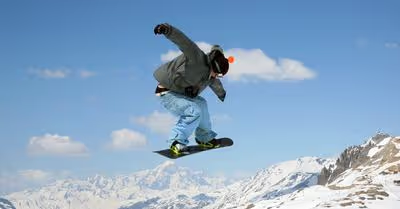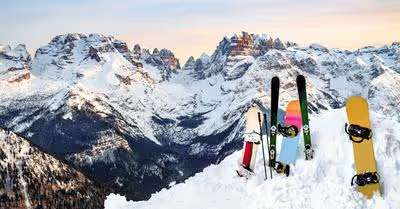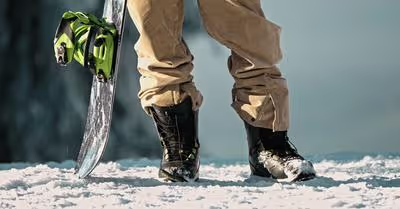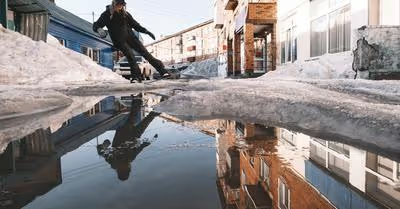Table of Contents
How To Pick The Right Size Snowboard
Picking the right size snowboard requires thinking through your body type, your snowboarding goals, and your experience level. Let’s start with the basic snowboard dimensions: length and width.
What Length Snowboard Should You Get?
The standard wisdom is that the length of your snowboard should be a little bit shorter than your height — specifically, it should fall between your nose and chin when standing on end in front of you. However, your height actually doesn’t have a significant impact on the size of your snowboard. Weight is much more important.
Snowboards are not flat. Traditional snowboards have a camber profile, which means they arc up at either end and between your feet. If you’re too heavy or too light for your snowboard, that camber profile won’t interact properly with the ground and you won’t have maximum control.
The height calculation is derived from average weight. If your weight is average for people your height, you can use your face to judge length safely. If you’re significantly heavier or lighter than average, you might want to establish a personal measuring system.
If you’re heavier than average, you might look for boards that fall between your nose and the top of your head for example, and if you’re lighter than average, you could try boards that fall between your chin and your chest.
If you’re shopping online, most companies will publish a suggested weight range for the different lengths of their snowboards. You don’t need to follow this strictly, but if you’re out of range by 100 pounds, you likely won’t be happy with the way the board performs.
Here is a size chart that takes height and weight and suggests a length of snowboard. It doesn’t take any additional factors into account, so it’s not a perfect calculation, but it will give you a ballpark of the length range you should be looking at. If your height and weight are significantly different, I recommend splitting the difference on this chart and then thinking about width and what your riding priorities are.
Most adult men ride boards in the 150-162 cm range. You should be really light to ride a board shorter than that, and boards in the high 160s or over 170 can be difficult to maneuver and are usually only for specific conditions or goals.
What Width Snowboard Should You Get?
Most manufacturers will provide a waist measurement for their snowboards. This is the width of the snowboard at its narrowest point in the center. Not all snowboards have the same shape, so two snowboards that are the same length may haven’t different waist measurements. However, each model has a standard shape, so if you get a longer version of a board, you’ll be getting a slightly wider version as well.
Deciding what width of snowboard you need requires thinking about your weight, your foot size, and your riding preferences. Many riders like to ride the narrowest boards they can safely, which means choosing a width where their toes and heels extend slightly over the edge of the board.
In terms of weight, you have to consider the total area of the snowboard, so you can’t consider length and width in isolation. This is how manufacturers list their weight recommendations for their boards. If you fit within that weight recommendation, you don’t need to specifically consider the width.
However, the fact that weight is spread over width and length gives you flexibility. If you prefer shorter snowboards, you might look for boards that have a naturally wider profile so that you can find a shorter board that fits your weight range.
The second big consideration for width is foot size. If your boots don’t reach the edges of your snowboard, you’ll have a really difficult time shifting your weight over each edge to be able to turn. On the other hand, if your toes and heels hang off your snowboard significantly, they’ll drag in the snow, which will make carving difficult and may make you more likely to fall.
Most snowboarders with a men’s boot size below 10 can buy a normally sized snowboard without considering width too much as long as the weight range is right. If you’re an 11 or 12, you’ll want to think a little more carefully about what width will allow you to ride safely.
In addition to listing waist measurements for all their snowboards, many manufacturers provide extra-wide versions of some of their models. These can be good options for heavier people or people with large feet, but you’ll sacrifice some responsiveness and turn quickness with an extra-wide board.
Now that we’ve explored the general considerations impacting snowboard size, what about the kind of riding you like to do?
What Size Snowboard Should You Get For Freestyle?
Generally, freestyle riders prefer shorter snowboards than are used for other styles of riding. Spinning off jumps or out of the halfpipe and butter tricks are all easier with a shorter board. Additionally, you’ll be less likely to catch an edge with a shorter board when a trick goes sideways.
This doesn’t mean you need to buy a separate freestyle board. As Zeb Powell has proved, you can perform tricks with any size board, and you still need a board that will accommodate your weight. But if you’re choosing between a board that’s 154cm long and one that’s 157cm long, you might choose the shorter option if you ride a lot of freestyle.
What Size Snowboard Should You Get For Powder
The goal of a powder board is to float on top of the snow, so a larger footprint is better. Traditionally, this meant powder boards were longer. However, recently a lot of companies have started making powder boards that are short and very wide.
If you’re looking for a board that will perform well in all conditions but especially well in powder, you may want to buy an all-mountain board and get it slightly longer than you otherwise would for an extra boost in powder.
If you can afford to have a board dedicated just to powder days, some of the shorter, fatter powder boards are very fun. But their width makes them difficult to ride on groomed trails, so they’re not recommended as your primary board.
What Size Snowboard Should A Beginner Get?
The longer a snowboard is, the more difficult it is to turn, the longer it takes to turn, and the more likely you are to catch an edge while turning. Because of this, it’s recommended for beginners to learn with a slightly shorter board than a similar-sized, experienced snowboarder might ride.
One of the most frustrating beginner experiences is trying to learn for the first time on a board that’s way too long and often old and stiff. It’s worth spending a little extra money to rent a snowboard specifically built for learning and sized for you for your first few lessons. Please turn down your friend’s offer to let you learn on their old board — you’ll thank me later.
What Size Snowboard Should Kids Get?
Most companies don’t make snowboards smaller than 2.5 to 3 feet in length. So if you’re buying for a 3-year-old, it’s usually as simple as buying the shortest board available. But by the time kids are about 10 (it has more to do with size than age), the normal sizing rules apply.
Like any other beginner, the worst thing you can do for a child learning to snowboard is to put them on a board that’s too big for them — too long or too wide can make it almost impossible for a kid to be successful. While it might be tempting to buy a board they can grow into, that won’t be a good investment if they give up on snowboarding altogether. You’ll be better off renting a board for them each season until they’ll be staying the same size for a few years in their teens.
Recent Articles



